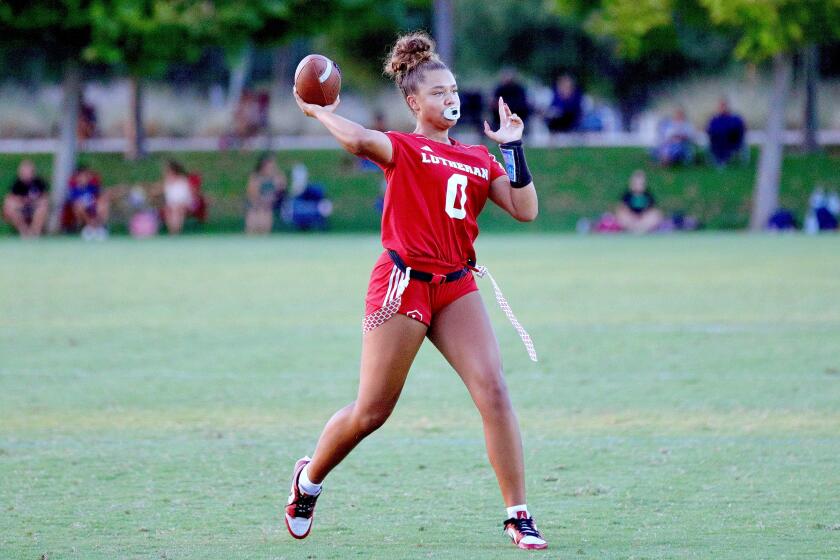Experiencing a Net Gain in Quality : Influence of Club Play Increases Talent Pool for Girls’ Volleyball
- Share via
SAN DIEGO — Serra High School senior Lynn Patrick, state high jump champion as a sophomore and runner-up as a junior, was talking about volleyball, the sport she temporarily gave up last spring to concentrate on track.
She told a story about a coach who was trying to talk her into playing club volleyball in Los Angeles, an adventure that would include doing homework in a car during a 2-hour-plus commute through rush hour traffic three times a week.
“He showed me a list of college volleyball recruits,” she said. “There were three pages of names, and out of all of those names, only one girl just played high school and didn’t play club.”
Patrick decided not to take the offer to play for the high-quality, well-established club, electing to stay in San Diego.
“Since San Diego volleyball is getting so much more competitive, it was beneficial to stay here,” she said.
Girls’ high school volleyball has indeed become more competitive than ever, most experts say. The reason is the development of players by clubs, and the result is the largest crop of college-caliber talent this county has had.
Four of the top five seniors are listed among the nation’s top 25 recruits, according to the Spoiler’s Scouting Service, a 9-year-old publication. Another, Alicia Turner of University of San Diego High School, is among the top 50. (One expert--Jess Money, high school writer for Volleyball Monthly magazine--says Turner is certainly among the top 35 and probably the top 25.)
The scouting service lists Patrick No. 5 among the nation’s most talented high school volleyball prospects. Francis Parker’s Heidi West is No. 19, San Pasqual’s Blair Noonan No. 22 and Morse’s Angel Leath No. 23.
Of those five, only Patrick didn’t play for the San Diego Volleyball Club’s (SDVBC’s) top 17-under team, which placed third in a national tournament over the summer. Patrick, who dropped out of the club after 2 months to concentrate on defending her high jump title, said she is now dedicated to volleyball. She said she will join the other four on the club’s 17-year-old team beginning in December and might not high jump this spring.
The talent pool doesn’t stop with those five. Dick Templeman, director for the San Diego Volleyball Club and a member of the USA Volleyball Board of Directors, says the list of Division I and II college prospects is 14 players deep and that there are three or four others who could develop into college prospects by the end of club season this summer. He also said that about 20 juniors--including Poway setter Amy Boyer, perhaps the county’s best player--could get to that level in another year.
It’s not that girls’ volleyball in the county has lacked college-level talent in the past. But this year, because of the strong club influence, the depth is among the nation’s best.
San Diego County has been the home of such outstanding college volleyball players as Suzanne Eagye, Ann and Cheri Boyer (Amy’s sisters), Kathy Luedeke and Sally Larsen. Eagye led Hawaii to the 1987 NCAA national title; Ann Boyer is perhaps the nation’s finest setter for the nation’s top-ranked team, UCLA; and Cheri Boyer, a freshman at Hawaii, might be better.
“There’s always been quality from San Diego,” Money said. “The great players have tended to be really great. Cheri Boyer is maybe the greatest setting prospect of all time. These kids were awesome when they were 15 years old. This year’s crop has nobody in that group--more depth, but the high isn’t as high.”
More girls are getting to that point because of the club, which is also the major reason more and more recruiters are coming to San Diego. The club isn’t a social affair for Sunday hitters. It’s a non-profit organization working to raise the quality of play locally to a nationally competitive level. It is also trying to help raise the high school level, still a big step down from club.
“The best example is taking the best players in San Diego and putting them all on one (high school) team, and that’s what every (club) team is like,” Turner said. “It’s tough.”
In the past 2 years, 16 players from the SDVBC have received NCAA Division I or Division II scholarships, and three others are playing at non-scholarship Division III schools.
“I would say that is higher than almost any other club in the U.S.,” Templeman said. “I’d say only Orange County Volleyball Club had more, or as many as we do.”
Wherever there are clubs, talent and talented teams can be found.
“That can be expanded to any area in the U.S. where the top high school teams are located,” Templeman said. “For example, the state champions in the top division, every year for the past 5 or 6 years, almost always have been from Orange County or Los Angeles areas. That’s because they have had the clubs in existence for the longest time period. Orange County and Los Angeles have had club volleyball for 10 years.”
So why have so many girls in San Diego County developed into potential college players?
“With respect to volleyball development,” Templeman said, “I think we (the club) play the biggest part in that because we have the kids for the most amount of time. We have the kids for 6 or 7 months whereas the high school coaches will only have them for 3 months.
“It (San Diego) is growing significantly as a hotbed for recruiting. We now have a vehicle for players to improve their skills on a year around basis.”
Where San Diego County drops off is at the high school level.
“The big problem San Diego has is the lack of high school competition,” Money said. “High school development in San Diego is really lagging. Up here (Los Angeles), players have 3 good months of high school and 7 months of clubs. Down there, high school doesn’t help that much. That’s the only thing (holding) San Diego from being one of the best talent sources in the country.”
Heidi West, from tiny Francis Parker, said her high school competition wouldn’t have been enough for her to develop into a potential college player.
“If I had relied only on my high school volleyball, it wouldn’t even get me to the point I am now,” West said. “I don’t think it hurts my playing, it’s kind of a rest before the fierce competition of the club.”
Martha McCarthy, Leath’s coach at Morse, agrees.
“I’m afraid we hurt her a little bit,” McCarthy said about Leath. “Playing on a team like our’s that doesn’t have the talent to be able to get ball to people with her skills doesn’t give her a chance to use it. Let’s face it, she’s one of the strongest hitters in the county. There have been a few games where she hasn’t been able to get a set to hit. I told her, ‘I’m sure glad you’re playing club ball.’ People from colleges coming out sure won’t be able to see her to her full potential.”
The club is working to raise the quality of play in San Diego to a nationally competitive level and maximize the exposure of its college-potential players. Inside the cover of the SDVBC’s 1988 yearbook is a list of the club’s primary goals. No. 4 states:
“ To assist our players in obtaining college scholarships for volleyball when they qualify through grades, entrance exams, attitude, and ability (over 300 colleges & universities now offer scholarships for volleyball). “
Division I schools have 12 full scholarships available, and Division II schools offer six.
As clubs in San Diego continue to develop and to help players to develop, those scholarship lists will include fewer and fewer non-club players.
More to Read
Get our high school sports newsletter
Prep Rally is devoted to the SoCal high school sports experience, bringing you scores, stories and a behind-the-scenes look at what makes prep sports so popular.
You may occasionally receive promotional content from the Los Angeles Times.





